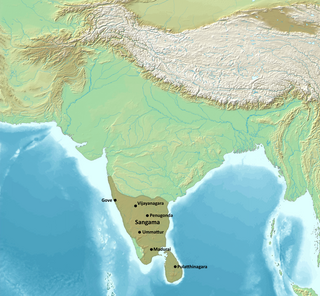
The Vijayanagara Empire was a medieval Hindu empire that covered much of the region of Southern India, ruling the lands of the modern states of Karnataka, Andhra Pradesh, Tamil Nadu, Kerala, Goa, and some parts of Telangana, Maharashtra and some parts of Sri Lanka. It was established in 1336 by the brothers Harihara I and Bukka Raya I of the Sangama dynasty, members of a pastoralist cowherd community that claimed Yadava lineage. The empire rose to prominence as a culmination of attempts by the southern powers to ward off Turco-Persian Muslim invasions by the end of the 13th century. At its peak, it conquered almost all of Southern India's ruling dynasties and pushed the Turco-Persian sultans of the Deccan beyond the Tungabhadra-Krishna River doab region, in addition to annexing Gajapati Empire (Odisha) up to the Krishna River, thus becoming a notable power.

The Pandyan dynasty, also referred to as the Pandyas of Madurai, was an ancient Tamil dynasty of South India, and among the four great kingdoms of Tamilakam, the other three being the Pallavas, the Cholas and the Cheras. Existing since at least the 4th to 3rd centuries BCE, the dynasty passed through two periods of imperial dominance, the 6th to 10th centuries CE, and under the 'Later Pandyas'. Under Jatavarman Sundara Pandyan I and Maravarman Kulasekara Pandyan I, the Pandyas ruled extensive territories including regions of present-day South India and northern Sri Lanka through vassal states subject to Madurai.

Krishnadevaraya was an emperor of the Vijayanagara Empire reigning from 1509 to 1529. He was the third monarch of the Tuluva dynasty, and is considered to be one of the greatest rulers in Indian history. He ruled the largest empire in India after the fall of the Islamic Delhi Sultanate. Presiding over the empire at its zenith, he is regarded as an icon by many Indians. Krishnadevaraya earned the titles Andhra Bhoja, Karnatakaratna Simhasanadeeshwara, Yavana Rajya Pratistapanacharya, Kannada Rajya Rama Ramana, Gaubrahmana Pratipalaka and Mooru Rayara Ganda. He became the dominant ruler of the peninsula by defeating the sultans of Bijapur, Golconda, the Bahmani Sultanate and the Gajapatis of Odisha, and was one of the most powerful Hindu rulers in India.

Aditya Chola I the son of Vijayalaya Chola, was the Chola king who laid the foundation of the Chola Empire with the conquest of the Pallava Kingdom and the occupation of the Western Ganga Kingdom and Kongu Nadu. Aditya Chola I was succeeded by his eldest son Parantaka Chola I.

Chola Nadu is a cultural region of the Tamil Nadu state in southern India. It encompasses the lower reaches of the Kaveri River and its delta, and formed the cultural homeland and political base of the Chola Dynasty which ruled large parts of South India and parts of Sri Lanka between the 9th and 13th centuries CE. Uraiyur served as the early Chola capital, then medieval Cholas shifted to Thanjavur and later cholas king Rajendra Chola I moved the capital to Gangaikonda Cholapuram in Ariyalur in the 11th century CE.

The Chola dynasty was a Tamil dynasty originating from southern India. At its height, it ruled over the Chola Empire, an expansive maritime empire. The earliest datable references to the Chola are from inscriptions dated to the 3rd century BCE during the reign of Ashoka of the Maurya empire. The Chola empire was at its peak and achieved imperialism under the Medieval Cholas in the mid-9th century CE. As one of the Three Crowned Kings of Tamilakam, along with the Chera and Pandya, the dynasty continued to govern over varying territories until the 13th century CE.
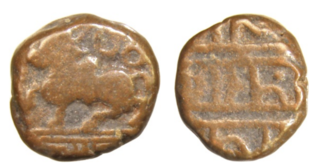
Deva Raya II was an emperor of the Vijayanagara Empire. The greatest of the Sangama dynasty rulers, he was an able administrator, warrior, and scholar. He authored well-known works in the Kannada language and in the Sanskrit language. He was patron to some of the most noted Kannada poets of the medieval period, including Chamarasa and Kumara Vyasa, the Sanskrit poet Gunda Dimdima, and the noted Telugu language poet Srinatha, whom the king honored with the title Kavisarvabhauma. He supported development in secular literature as well as the noted South Indian mathematician Parameshvara, from the Kerala school of astronomy and mathematics lived in his empire.

Vijayalaya Chola was a descendant of the Early Cholas, who revived the Chola dynasty and founded the Imperial Chola Empire. He ruled over the region to the north of the river Kaveri. He is one of the descendants of the famous Sangam age Chola king, Karikala Chola. According to the Anbil plates of Parantaka Chola II, his predecessor is Srikantha Choladhiraja, a Telugu Chola king who ruled the Renadu region, belongs to the Pottapi Chola lineage, and is a descendant of the ancient Tamil king, Karikala Chola. Vijayalaya was succeeded by his son Aditya Chola I who laid the foundation of the Imperial Chola Empire.

Karikala often referred to as Karikala the Great was a Tamil king of the Early Cholas of the Chola dynasty who ruled ancient Tamilakam from Uraiyur. He is credited with the construction of the flood banks of the river Kaveri. He is recognised as the greatest of the Early Cholas. In Thiruvalangadu plates of Rajendra Chola I, Medieval Tamil Cholas listed Karikala Chola as one of their ancestors. In Malepadu plates of Renati Chola king Punyakumara, Telugu Cholas claimed that they belong to the family of Karikala Chola and praises him for stopping the overflow over the banks of river Kaveri. Kakatiya king Ganapati-deva's Garavapadu charter traces the family's ancestry to Durjaya, a descendant of Karikala Chola who arrived at a town called Kakati during a hunting expedition, and set up his camp there.Many other Telugu dynasties also claimed descendant from Karikala Chola.
Agattiyam, also spelled as Akattiyam, according to Tamil tradition, was the earliest book on Tamil grammar. It is a non-extant text, traditionally believed to have been compiled and taught in the First Sangam, by Agattiar (Agastya) to twelve students. A few surviving verses of Akattiyam are said to be quoted in medieval commentaries.
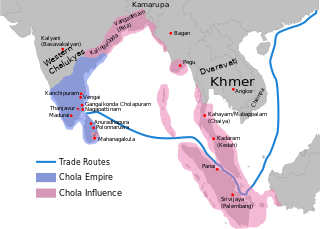
The Chola Empire, which is often referred to as the Imperial Cholas, was a medieval Indian, thalassocratic empire that was established by the Pottapi branch of the Chola dynasty that rose to prominence during the middle of the ninth century and united southern India under their rule.
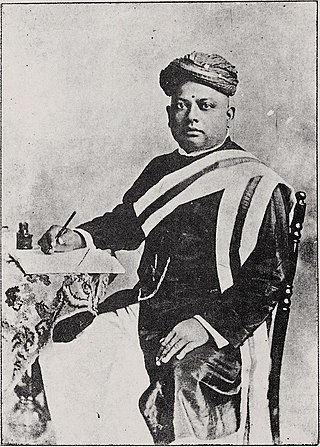
S. M. Natesa Sastri (1859–1906) was a polyglot, scholar in eighteen languages and authored many books in Tamil, Sanskrit and English. His scholarliness over Tamil and Sanskrit languages got him the title "Pandit'.
Chamarasa was a 15th century Virashaiva poet in the Kannada language, during the reign of Vijayanagar Empire, a powerful empire in Southern India during 14th - 16th centuries. A contemporary and competitor to a noted Brahmin Kannada poet Kumara Vyasa, Chamarasa was patronised by King Deva Raya II. The work is in 25 chapters (gatis) comprising 1111 six-line verses (arupadi).

Iravatham Mahadevan was an Indian epigraphist and civil servant, known for his decipherment of Tamil-Brahmi inscriptions and for his expertise on the epigraphy of the Indus Valley civilisation.
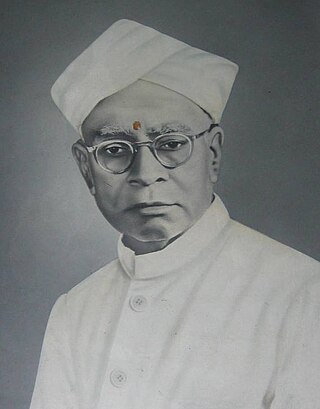
Kallidaikurichi Aiyah Nilakanta Sastri was an Indian historian who wrote on South Indian history. Many of his books form the standard reference works on the subject. Sastri was acclaimed for his scholarship and mastery of sources and was a recipient of the third highest Indian civilian honour, the Padma Bhushan.
Diwan Bahadur Sakkottai Krishnaswamy Aiyangar was an Indian historian, academician and Dravidologist. He chaired the Department of Indian History and Archaeology at the University of Madras from 1914 to 1929.

Rangachari Champakalakshmi was an Indian historian and social scientist whose work focused on the study of early and pre-modern South Indian history. She served as a professor in the Centre for Historical Studies, Jawaharlal Nehru University (JNU). In addition, Champakalakshmi was president of the Indian History Congress.
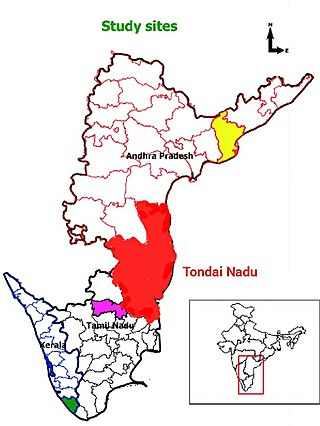
Tondaimandalam, also known as Tondai Nadu, is a historical region located in the northernmost part of Tamil Nadu and southernmost part of Andhra Pradesh. The region comprises the districts which formed a part of the legendary kingdom of Athondai Chakravarti. The boundaries of Tondaimandalam are ambiguous – between the river basins of Penna River and Ponnaiyar River. During the reign of Rajaraja I, this region was called as Jayankonda Cholamandalam.















